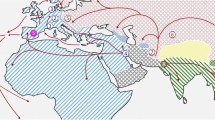Abstract
HSRs (homogeneously staining regions) are the cytological correlates of DNA amplification. In the house mouse, Mus musculus, many populations are polymorphic for the presence or absence of HSRs on chromosome 1. In the semispecies M. m. domesticus the amplified DNA is present within one HSR, whereas in M. m. musculus chromosomes 1 with two HSRs are found. Hybridization of HSR-specific probes to Southern blots of HSR-carrying genomic DNAs from different localities and semispecies revealed similar complex band patterns. the remaining variation is restricted to sequences with a low degree of amplification. Variation is higher between semispecies than within one semispecies. It is assumed that HSRs are derived from one original amplification event and that unequal recombination is the mechanism underlying the length variation of HSRs present today in both semispecies. Evidence from G-banding and in situ hybridization shows that the two HSRs of M. m. musculus originated from a single HSR by means of a paracentric inversion, where one break-point was located within the single HSR and the second outside the HSR. As a consequence of the paracentric inversion the two HSRs of M. m. musculus are permanently linked together. Since exchange of genes between the two semispecies is restricted to a narrow hybrid zone the amplification that gave rise to the HSR most probably occurred prior to the divergence into the semispecies M. m. domesticus and M. m. musculus about 1 million years ago.
Similar content being viewed by others
References
AgulnikSI, GorlovIP, AgulnikAI (1988) Mouse Chr 1 with two insertions: Is(HSR;1C5)1Icg and Is(HSR;1E3)2Icg. Mouse Newslett 76: 70
BoldyreffB, WinkingH, WeithA, TrautW (1988) Evidence for in situ amplification of a germ line homogeneously staining region in the mouse. Cytogenet Cell Genet 47: 84–85
BonhommeF, ThalerL (1988) L'évolution de la souris. La Recherche 199: 604–616
BorodinPM, GorlovIP, LadyginaTY (1990) Double insertion of homogeneously staining regions in chromosome 1 of wild Mus musculus musculus: Effects on chromosome pairing and recombination. J Hered 81: 91–95
ChandlerME, YunisJJ (1978) A high resolution in situ hybridization technique for the direct visualization of labeled G-banded early metaphase and prophase chromosomes. Cytogenet Cell Genet 22: 352–356
FerrisSD, SageRD, HuangCM, NielsenJT, RitteU, WilsonAC (1983) Flow of mitochondrial DNA across a species boundary. Proc Natl Acad Sci USA 80: 2290–2294
KrügerJ, VogelF (1975) Population genetics of unequal crossing over. J Mol Evol 4: 201–247
MoriwakiK, MiyashitaH, SuzukiH, KuriharaY, Yonekawa (1986) Genetic features of major geographical isolates of Mus muculus. Curr Top Microbiol Immunol 127: 55–61
NunbergJH, KaufmanRJ, SchimkeRT, UrlaubG, ChasinLA (1978) Amplified dihydrofolate reductase genes are localized to a homogeneously staining region of a single chromosome in a methotrexate-resistant Chinese hamster ovary cell line. Proc Natl Acad Sci USA 75: 5553–5556
OhnoS (1970) Evolution by gene duplication. Springer, Berlin Heidelberg New York
SaidK, JacquartT, MontgelardC, SonjayaH, HelalAN, Britton-DavidianJ (1986) Robertsonian house mouse populations in Tunisia: a karyotypical and biochemical study. Genetica 68: 151–156
SchwabM, AlitaloK, VarmusHE, BishopJM, GeorgeD (1983) A cellular oncogene (c-Ki-ras) is amplified, overexpressed, and located within karyotypic abnormalities in mouse adrenocortical tumor cells. Nature 303: 497–501
SeabrightM (1971) A rapid banding technique for human chromosomes. Lancet ii: 971–972
SumnerAT (1972) A simple technique for demonstrating centromeric heterochromatin. Exp Cell Res 75: 304–306
TrautW, WinkingH, AdolphS (1984) An extra segment in chromosome 1 of wild Mus musculus: a C-band positive homogenously staining region. Cytogenet Cell Genet 38: 290–297
TrimanKL, DavissonMT, RoderickTH (1975) A method for preparing chromosomes from peripheral blood in the mouse. Cytogenet Cell Genet 15: 166–176
VanlerbergheF, DobB, BoursotP, BellisM, BonhommeF (1986) Absence of Y-chromosome introgression across the hybrid zone between Mus musculus domesticus and Mus musculus musculus. Genet Res 48: 191–197
WeithA, WinkingH, BrackmannB, BoldyreffB, TrautW (1987) Microclones from a germ line HSR detect amplification and complex rearrangements of DNA sequences. EMBO J 6: 1295–1300
YakimenkoLV, KorobitsynaKV (1988) A rare variant of the chromosome 1 in house mouse: occurrence of two extra heterochromatin segments. Genetika 24: 376–378
Author information
Authors and Affiliations
Additional information
by D. Schweizer
Rights and permissions
About this article
Cite this article
Winking, H., Weith, A., Boldyreff, B. et al. Polymorphic HSRs in chromosome 1 of the two semispecies Mus musculus musculus and M. m. domesticus have a common origin in an ancestral population. Chromosoma 100, 147–151 (1991). https://doi.org/10.1007/BF00337242
Received:
Accepted:
Issue Date:
DOI: https://doi.org/10.1007/BF00337242




